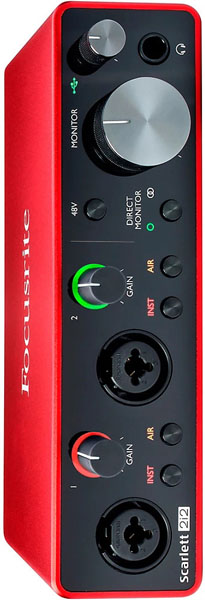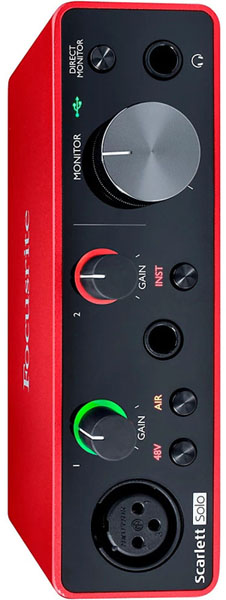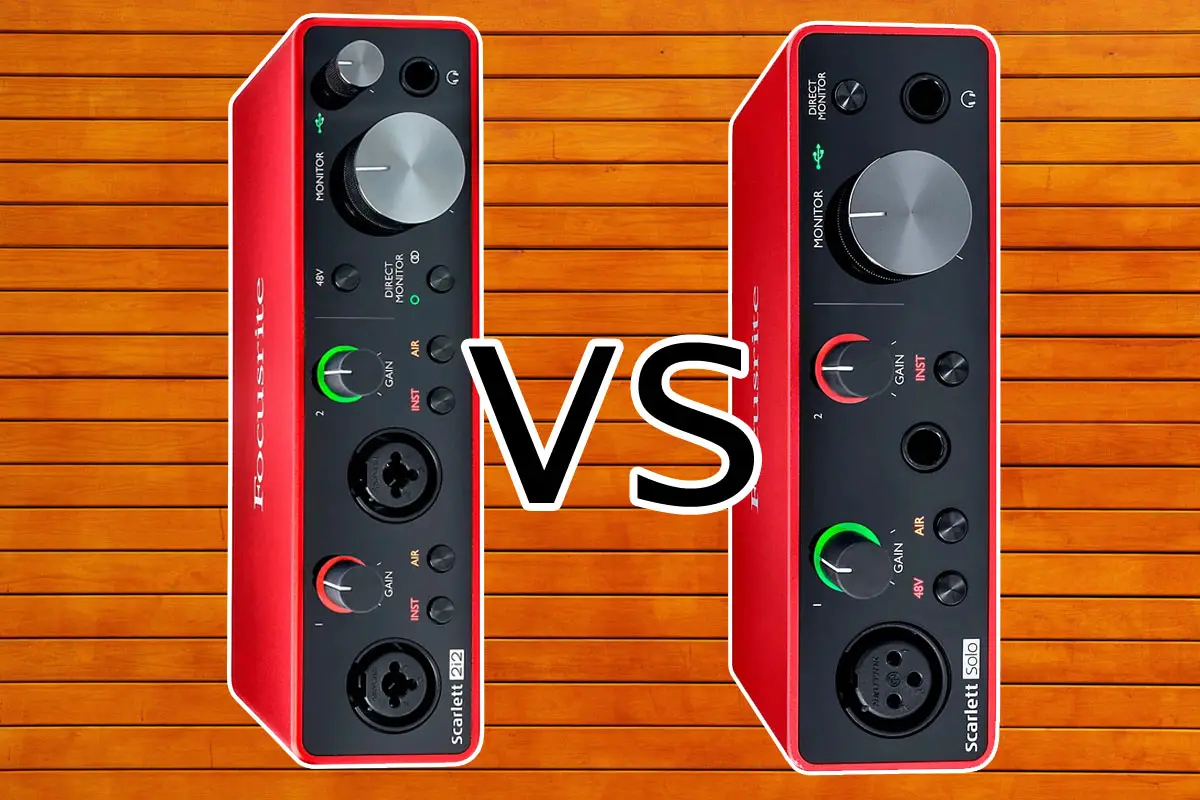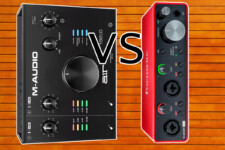Focusrite Scarlett 2i2 3rd Gen vs Focusrite Scarlett Solo 3rd Gen: Which One Should You Get?
If you are looking for a simple and affordable way to record your music, podcasts, or other audio projects, you might be interested in the Focusrite Scarlett series of USB audio interfaces. These devices allow you to connect your microphones, instruments, and speakers to your computer and capture high-quality sound with minimal latency and hassle.
But which one should you choose: the Focusrite Scarlett 2i2 3rd Gen or the Focusrite Scarlett Solo 3rd Gen? Both are popular models that offer similar features and performance, but there are some key differences that might make one more suitable for your needs than the other. In this article, we will compare these two interfaces and help you decide which one is the best for you.

A Quick Look
If you want a simple and portable audio interface that can handle one microphone and one instrument at a time, you may want to choose the Focusrite Scarlett Solo 3rd Gen. It has a single XLR input with a high-quality mic preamp, a high headroom instrument input, and a headphone jack. It also has a button to activate the phantom power, the Air mode, and the direct monitor circuit. It is USB-powered and weighs only 0.79 lbs, making it easy to carry around.
If you want more flexibility and versatility in recording two sources simultaneously, you may want to choose the Focusrite Scarlett 2i2 3rd Gen. It has two combo mic/line/instrument inputs with the same mic preamps as the Solo, but with more gain range and halo level indicators. It also has two balanced 1/4″ TRS main outputs, a headphone output with level control, and a master gain knob. It also has the same buttons as the Solo, plus a switch for selecting between line or instrument level input. It is also USB-powered, but weighs slightly more at 1.03 lbs.

Focusrite Scarlet 2i2 3rd Gen
- High-performance 24-bit/192kHz converters that deliver studio-quality sound.
- Two independent gain knobs with LED halo indicators that show the input level and clipping status.
- Two high-headroom instrument inputs for bass, guitar, or synths that can handle loud signals without clipping.
- Two balanced TRS outputs that can connect to studio monitors or speakers.
- USB-C connectivity that provides fast and reliable data transfer and power supply.
- A dedicated amplifier that can drive high-impedance headphones.
- Line or instrument level input selection switch.

Focusrite Scarlett Solo 3rd Gen
- Mobile-ready, bus-powered, 2-in/2-out USB-C.
- Record at up to 24-bit/192kHz resolution.
- One XLR input with mic preamp, and one high headroom instrument input.
- Two balanced 1/4″ TRS main outputs.
- Switchable Air mode that gives recordings a brighter and more open sound.
- Unique halo level indicators that show you the input level and signal clipping.
- A direct monitor circuit that lets you monitor your input with low latency.
- 48V Phantom power switch for condenser microphones.
Price Comparison
The Focusrite Scarlett Solo 3rd Gen is cheaper than the Focusrite Scarlett 2i2 3rd Gen, as you might expect from its simpler design and features. The Scarlett Solo has a recommended retail price of $129.99, but you can find it online for around $100. The Scarlett 2i2 has a recommended retail price of $179.99, but there are often online sale prices of about $150, so if you see a higher price it’s a sign to shop around a bit more.
So, the price difference between the Focusrite Scarlett Solo 3rd Gen and the Focusrite Scarlett 2i2 3rd Gen is not huge, considering what you get with each device. However, if you are on a tight budget or just want a simple and easy-to-use interface, you might prefer the Focusrite Scarlett Solo 3rd Gen. If you are willing to spend a bit more or want a more flexible and professional interface, you might prefer the Focusrite Scarlett 2i2 3rd Gen.
Common Features
Both the Focusrite Scarlett 2i2 3rd Gen and the Focusrite Scarlett Solo 3rd Gen share some common features that make them attractive options for audio recording. Here are some of them:
- High-performance 24-bit/192kHz converters that deliver clear and detailed sound quality.
- Upgraded 3rd-generation Scarlett mic preamps that provide low noise and high headroom. They also have a switchable Air mode that adds brightness and openness to your vocals and acoustic instruments, emulating the sound of Focusrite’s legendary ISA mic preamp.
- A USB-C port that connects to your computer and provides bus power, meaning you don’t need an external power supply. They also have low latency, allowing you to monitor your input with native plug-in effects in real time.
- A Direct Monitor circuit that lets you hear your input directly from the interface, bypassing your computer. You can switch between Off, Mono, and Stereo modes depending on your preference.
- They come with a software bundle that includes Ableton Live Lite, Pro Tools First Creative Pack, Red Plug-in Suite, Focusrite Collective access, and a free 3-month Splice Sounds subscription. These tools give you everything you need to start recording, editing, mixing, and producing your music.
- Both interfaces are made with a sturdy metal box.
Focusrite Scarlett Solo 3rd Gen Unique Features
- High headroom instrument input: This input allows you to plug in your guitar or bass directly without the need for a DI box or a separate instrument preamp.
- Lighter weight: This audio interface weighs only 0.79 lbs, making it easier to carry around than the 2i2, which weighs 1.03 lbs.
Focusrite Scarlett 2i2 3rd Gen Unique Features
- Two combo inputs: This audio interface has two combo mic/line/instrument inputs, which means you can connect two microphones, two instruments, or a combination of both at the same time.
- Two balanced outputs: This audio interface has two balanced 1/4″ TRS main outputs, which means you can connect them to studio monitors or other balanced devices for better sound quality and reduced noise.
- Halo level indicators: This audio interface has LED rings around the gain knobs that change color to indicate the input level and signal clipping at a glance.
- Line/instrument switch: This audio interface has a switch for selecting between line or instrument level input, which means you can adjust the input impedance and gain to match the source signal.
Sound Quality
Both interfaces offer excellent sound quality, thanks to their high-resolution converters and preamps. However, there is one difference that might affect your sound quality: the number of inputs and outputs.
The Focusrite Scarlett 2i2 3rd Gen has two combo XLR/TRS inputs that can accept both microphones and line-level or instrument-level signals. This means that you can record two sources at the same time, such as two vocals, two guitars, or a vocal and a guitar. You can also adjust the gain of each input independently, using the halo indicators to avoid clipping or distortion.
The Focusrite Scarlett Solo 3rd Gen has one XLR input for microphones and one TRS input for instruments. This means that you can only record one source at a time, either a vocal or an instrument. You can also adjust the gain of each input independently, but you have to switch between instrument and line levels using a button.
The number of inputs and outputs also affects the number of outputs. The Focusrite Scarlett 2i2 3rd Gen has two balanced TRS outputs that connect to your studio monitors or speakers. This gives you a stereo sound output that matches your stereo input. The Focusrite Scarlett Solo 3rd Gen has one balanced TRS output that connects to your studio monitor or speaker. This gives you a mono sound output that sums up your input.
Compatibility
Both interfaces are compatible with Mac and Windows computers, as well as iOS devices using a USB camera adapter (sold separately). They also work with any DAW (digital audio workstation) software that supports ASIO or Core Audio drivers. However, there is one difference that might affect your compatibility: the USB type.
The Focusrite Scarlett 2i2 3rd Gen has a USB-C port that connects to your computer using a USB-C to USB-A cable (included). This means that you can use it with any computer that has a USB-A port, which is most computers nowadays. However, if your computer has a USB-C port only, you will need to buy a USB-C to USB-C cable (not included) or use an adapter.
The Focusrite Scarlett Solo 3rd Gen has a USB-C port that connects to your computer using a USB-C to USB-C cable (included). This means that you can use it with any computer that has a USB-C port, which is becoming more common in newer models. However, if your computer has a USB-A port only, you will need to buy a USB-C to USB-A cable (not included) or use an adapter.
Focusrite Scarlett 2i2 3rd Gen Pros
- Two inputs and outputs for stereo recording and playback.
- Independent gain control for each input.
- Balanced outputs for better sound quality and noise reduction.
- Suitable for recording duets, podcasts, or multi-instrumentalists.
Focusrite Scarlett 2i2 3rd Gen Cons
- More expensive than the Solo.
- Requires a USB-C to USB-C cable or adapter for some computers.
Focusrite Scarlett Solo 3rd Gen Pros
- Cheaper than the 2i2.
- Includes a USB-C to USB-C cable for newer computers.
- Suitable for recording solo vocals, guitars, or keyboards.
Focusrite Scarlett Solo 3rd Gen Cons
- One input and output for mono recording and playback.
- Requires switching between instrument and line levels for the TRS input.
- Unbalanced output for lower sound quality and more noise.
Which One Would You Choose?
If you are looking for a simple and affordable interface that can record one source at a time, such as a vocal or a guitar, the Focusrite Scarlett Solo 3rd Gen might be the best option for you. It offers great sound quality, easy setup, and compatibility with most computers and software.
However, if you are looking for a more versatile and professional interface that can record two sources at the same time, such as two vocals, two guitars, or a vocal and a guitar, the Focusrite Scarlett 2i2 3rd Gen might be the best option for you. It offers better sound quality, more control, and balanced outputs for your studio monitors or speakers.
Ultimately, both interfaces are excellent choices for audio recording, and you can’t go wrong with either one. The best way to decide is to try them out yourself and see which one suits your style and workflow better.

The Final Verdict
The Focusrite Scarlett 2i2 3rd Gen and the Focusrite Scarlett Solo 3rd Gen are both high-quality USB audio interfaces that offer similar features and performance. However, there are some key differences that might make one more suitable for your needs than the other.
The main difference is the number of inputs and outputs. The 2i2 has two combo inputs and two balanced outputs, while the Solo has one XLR input, one TRS input, and one unbalanced output. This affects the sound quality, the flexibility, and the compatibility of each interface.
The 2i2 is more expensive than the Solo, but it also offers more value for money. It is ideal for recording stereo sources, such as duets, podcasts, or multi-instrumentalists. It also provides better sound quality and noise reduction with its balanced outputs.
The Solo is cheaper than the 2i2, but it also offers less functionality. It is ideal for recording mono sources, such as solo vocals, guitars, or keyboards. It also includes a USB-C to USB-C cable for newer computers.
Both interfaces are great options for audio recording, but they cater to different users and scenarios. The Focusrite Scarlett 2i2 3rd Gen is more suitable for those who want more versatility and professionalism in their recordings. The Focusrite Scarlett Solo 3rd Gen is more suitable for those who want simplicity and affordability.




